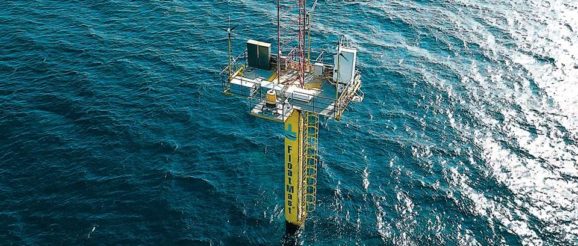Greek innovation in offshore wind power | Community | ekathimerini.com

Greek companies have enhanced the dynamic international wind energy field with valuable innovations, especially at sea. Among these innovations is Floatmast, a floating tension leg platform (TLP) mast for offshore wind measurement, which is a world first.
The groundbreaking invention was awarded by the European Commission and granted 2 million euros in funding.
In recent years, the number of wind turbines on offshore wind platforms has been increasing internationally. These platforms are an expensive investment, and to determine the ideal location for their placement, precise wind field measurements are needed.
These measurements are not easy to take at sea. Two basic methods have been used to date: The first involves the installation of a measurement tower, or met mast, which is attached to the bottom of the sea; this is a very reliable but also very expensive method, especially at great depths. The second entails the use of floating buoys equipped with LiDAR laser sensors; this method is cheaper but less reliable.
“An offshore wind farm is a big investment and this is why it is of crucial importance to precisely measure the wind field prior to its installation. A false valuation off by 2-3 percent can potentially cost millions, hence we seek maximum precision,” Antonis Peppas, managing director at ETME Peppas & Associates, tells Kathimerini.
The project is an initiative of ETME Peppas & Associates, together with Streamlined Naval Architects.
“The question for us was to combine the met mast’s reliability with the cost and the logic behind the floating buoy. This is what the innovation consists of, as well as our patent. Floatmast is an offshore floating platform built to the strictest criteria worldwide on wind measurement, lowering costs for investors by 60-70 percent but with the same quality output,” Peppas points out.
To achieve this successful combination, the company employed TLP technology used in oil platform design.
A TLP is made of four seabed anchors placed at the bottom of the sea, held by four tethers that connect the seabed anchors to the platform on the surface where the met mast is placed.
To record wind data, Floatmast uses a 40-meter met mast as well as LiDAR (light detection and ranging) sensors with a 200-meter range.
Additionally, the structure is completely energy autonomous as it is equipped with solar reflectors which not only cover the met mast’s energy needs, but also those of numerous meteorology and environmental sensor systems, highlighting Floatmast’s versatility.
“Our innovation’s utility value lies in the fact that our device can measure the wind blowing in a particular area with the greatest precision, allowing the investor to know exactly how profitable the offshore wind farm construction will be. At the same time, this floating structure is a complete maritime weather monitoring station, as it is equipped with a great number of sensors – blue and green – aimed at the environmental observation of the sea. This system can be installed before or during the construction of the offshore wind farm, and it can remain while the system operates, constantly monitoring the environmental parameters in a holistic way,” Peppas highlights.
Floatmast records data that include wind speed (at heights of between 20 and 210 meters), wind direction, wind temperature, humidity, atmospheric pressure, wave height and period, sea salt levels, sea temperature and chlorophyll levels.
The platform records a total of 42 different parameters on 120 different information channels. As mentioned by Peppas, the system can also support a bird detection system, as well as other radars monitoring sea life.
Floatmast has been installed and undergoing testing for the past five months off the Cavo d’Oro coast between the islands of Makronisos and Andros, a region where high winds and strong waves are common. The device has displayed flawless performance even in the harshest weather conditions.
“Even when wind gusts rose to 11 Beaufort, it remained steady as ever, with a slope degree of less than 1,” Peppas says. Floatmast will remain in the same spot for 12 months in total, to allow for the creation of a complete record of the surrounding data.
Floatmast has already caught the attention of foreign and Greek companies due to its innovative approach, especially the fact that it can start operating before, during or after the floating wind farm is installed.
In any case, it is of the utmost importance for Greece to have pioneering domestic companies in cutting-edge technologies like blue energy, which consists of water-based renewable energy production, in an era when the issue of climate change is constantly at the fore.
